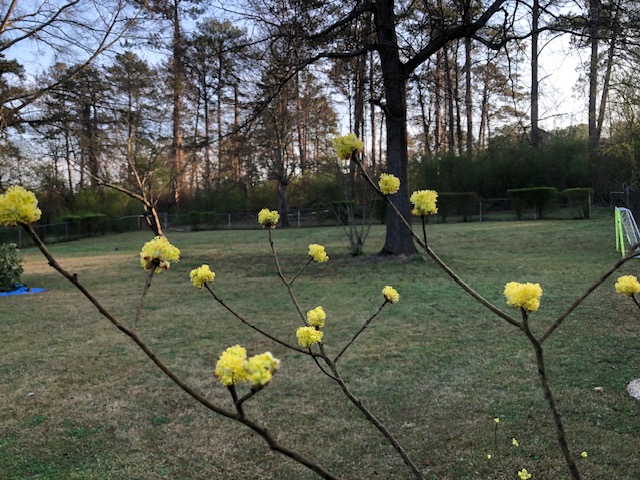By Jenna Jones, Trussville Tree Commission
June is National Pollinator Month and the beginning of summer! National Pollinator Week, recognized June 19 – June 23 this year, was unanimously approved in 2007 after the United States Senate recognized the urgency to protect our nation’s pollinators: bees, birds, butterflies, bats and flies to name a few. The urgency? Due to a variety of stresses, close to 40% of invertebrate pollinators are in danger of extinction. A decline in the pollinators is a decline in our nation’s food sources. We can thank a pollinator for every third bite of a meal.

Sassafras spring bloom
Of course, the pollinators cannot exist without the plants that provide a means for pollination, food and shelter. The summer annuals and perennials are alive with colorful blooms. One can easily witness the bees, butterflies, etc. that these flowers attract. However, let’s give the trees their due credit. Their blooms start attracting the pollinators from late winter to early spring (depending on the zone). Due to their showy blooms, fruit trees such as apples, pears and plums may be the first to come to mind. But ask the bee keepers what triggers the first honey flow and most will agree on the blooms of the native red maples!
Another bee magnet is the sassafras tree, but it is also a host tree to many butterflies and moths including the spicebush swallowtail butterfly. A host tree is shelter where female insects lay eggs, then larvae hatch and feed. In fall, many songbirds relish the sassafras berries. It’s just a beautiful tree for all seasons!
Other significant natives that attract pollinators are chokecherry, serviceberry, Eastern redbud, tulip poplar, crabapple, sourwood, and the infamous black tupelo.
So what can we do to encourage the pollinators?
Plant trees. Late fall and winter are the prime seasons to plant trees, but start your research now. Remember “right tree, right location”. Also, consult with a dependable garden center or grower and express your interest in a specific tree. Orders may be time sensitive.

Sassafras in the summer
Support your local beekeeper. They are probably harvesting in June/July. Don’t let the price of local honey make you pause. Honey is worth its weight in gold! Believe me. Thank the beekeeper! (Bees need trees. Trees need bees.)
Explore pollinator books with your children at local bookstores and libraries. The Birmingham Botanical Gardens Public Library is also a wonderful resource.
Incorporate native herbaceous plants and trees in your existing landscape or start your own pollinator garden. Use a wide variety of plants to support cyclic blooming from spring to fall.
Practice Integrated Pest Management (IPM) for an environmentally sensitive and common sense approach to pest management.
And finally, visit your local pollinator gardens. Take a peek behind the Trussville Public Library. Thanks to the library staff (kudos to Maura Davies!), volunteers and donations, the Butterfly/Pollinator Garden is thriving! Note the trees: ‘forest pansy’ red bud, black willow and sassafras!

Sassafras, a tree for all seasons! (Sassafras in the fall)








